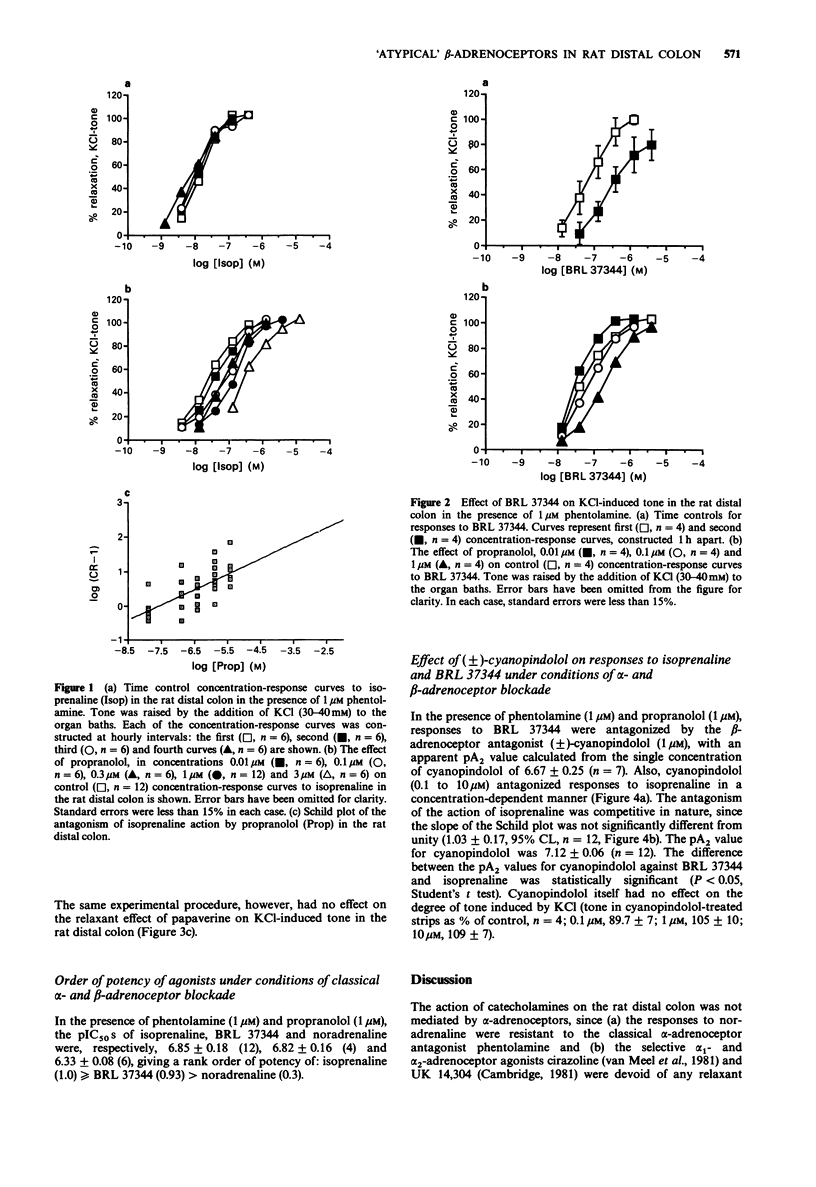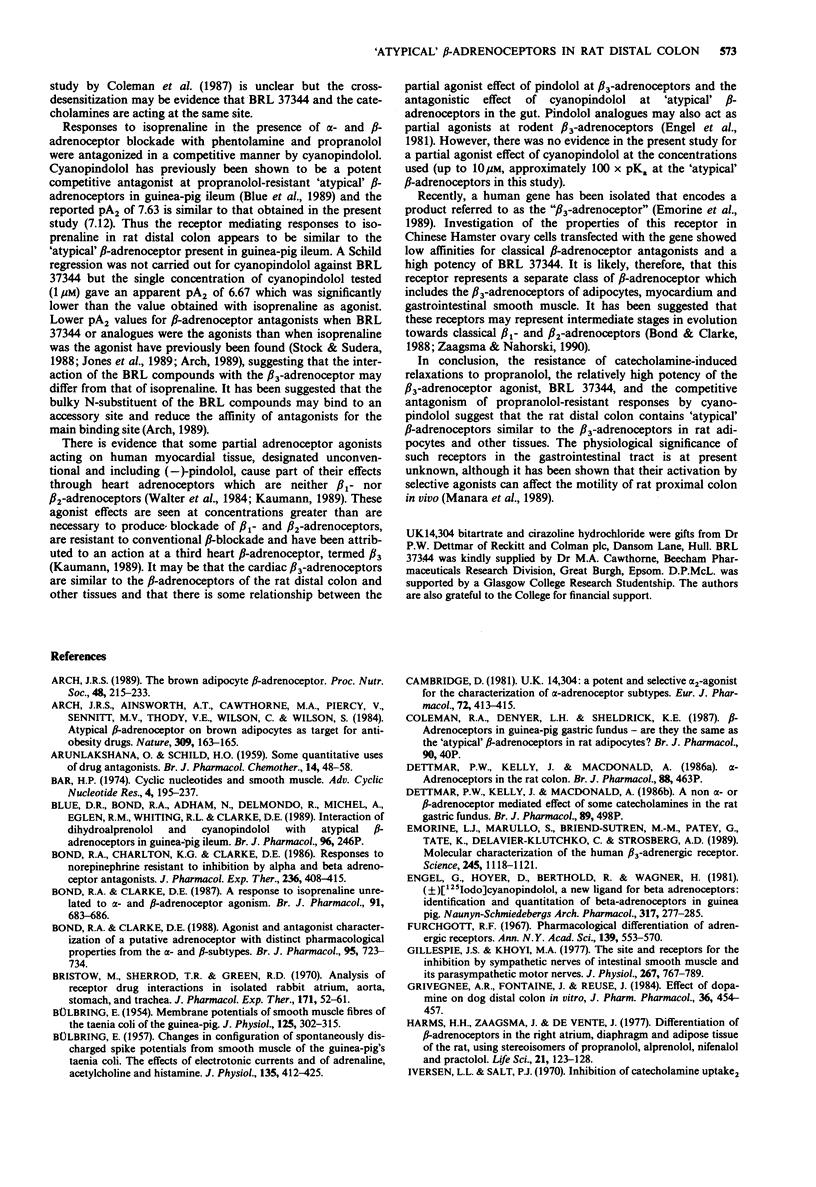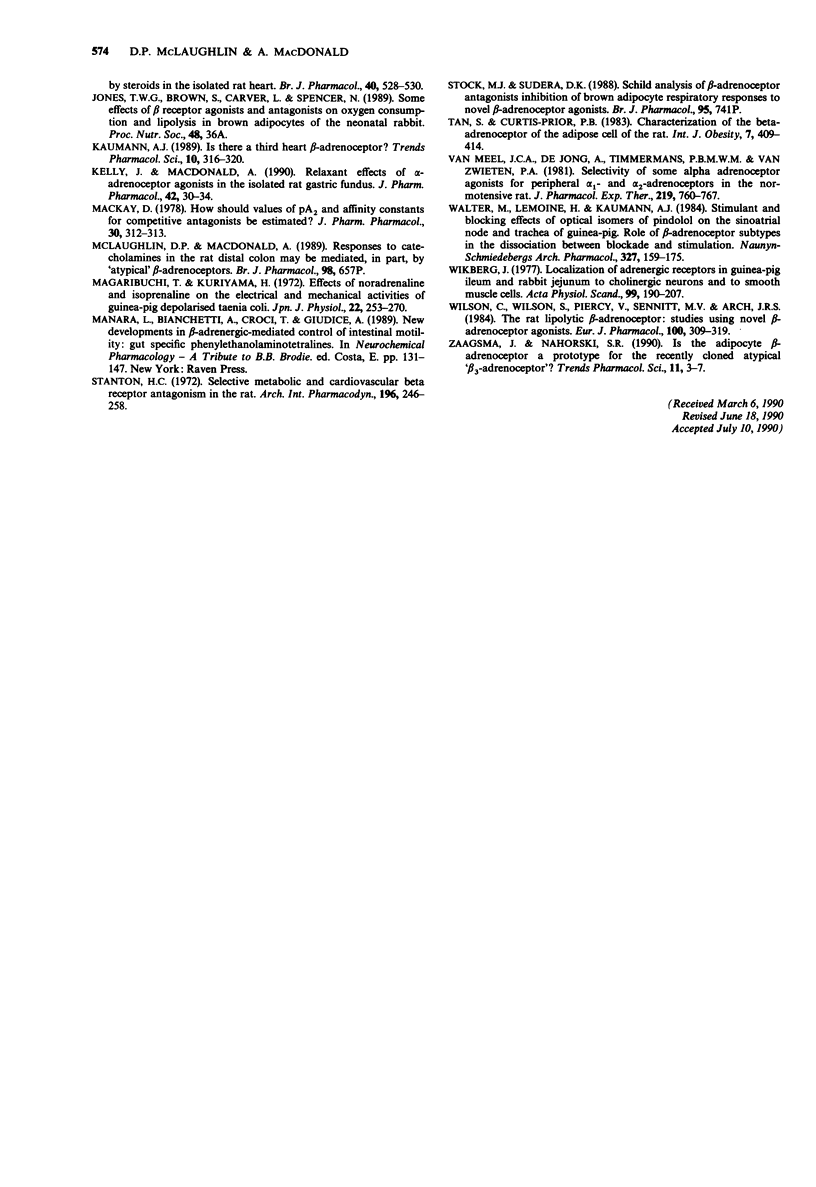Abstract
1. Experiments were carried out to characterize the adrenoceptors mediating relaxant responses in the rat distal colon. Three agonists were used: noradrenaline, isoprenaline and the beta 3-adrenoceptor agonist BRL 37344. Phentolamine, propranolol and (+/- )-cyanopindolol were tested as antagonists. Tone in the rat distal colon was induced with KCl (30-40 mM) as a spasmogen, and relaxations of this KCl-induced tone produced by the agonists were measured. 2. Relaxant responses to noradrenaline that were obtained in the presence of propranolol (1 microM) were not antagonized by phentolamine (0.01 to 1 microM). Relaxant responses to isoprenaline that were obtained in the presence of phentolamine (1 microM) were antagonized in a concentration-dependent manner by propranolol (0.01 to 3 microM), although this antagonism was weak and non-competitive. Relaxant responses to BRL 37344 that were obtained in the presence of phentolamine (1 microM) were only weakly antagonized by high (1 microM) concentrations of propranolol. 3. Tachyphylaxis to BRL 37344 was observed, a second concentration-response curve being shifted to the right by 15 fold. Exposure of the tissues to BRL 37344 (1 microM) between concentration-response curves also caused rightward shifts in the responses to noradrenaline (18 fold) and isoprenaline (19 fold) but not to papaverine. 4. In the presence of phentolamine (1 microM) and propranolol (1 microM), the rank order of potency of the agonists was: (-)-isoprenaline (1.0) greater than or equal to BRL 37344 (0.93) greater than (-)-noradrenaline (0.3).(ABSTRACT TRUNCATED AT 250 WORDS)
Full text
PDF





Selected References
These references are in PubMed. This may not be the complete list of references from this article.
- ARUNLAKSHANA O., SCHILD H. O. Some quantitative uses of drug antagonists. Br J Pharmacol Chemother. 1959 Mar;14(1):48–58. doi: 10.1111/j.1476-5381.1959.tb00928.x. [DOI] [PMC free article] [PubMed] [Google Scholar]
- Arch J. R., Ainsworth A. T., Cawthorne M. A., Piercy V., Sennitt M. V., Thody V. E., Wilson C., Wilson S. Atypical beta-adrenoceptor on brown adipocytes as target for anti-obesity drugs. Nature. 1984 May 10;309(5964):163–165. doi: 10.1038/309163a0. [DOI] [PubMed] [Google Scholar]
- Arch J. R. The brown adipocyte beta-adrenoceptor. Proc Nutr Soc. 1989 Jul;48(2):215–223. doi: 10.1079/pns19890032. [DOI] [PubMed] [Google Scholar]
- BULBRING E. Changes in configuration of spontaneously discharged spike potentials from smooth muscle of the guinea-pig's taenia coli; the effect of electrotonic currents and of adrenaline, acetylcholine and histamine. J Physiol. 1957 Feb 15;135(2):412–425. doi: 10.1113/jphysiol.1957.sp005720. [DOI] [PMC free article] [PubMed] [Google Scholar]
- BULBRING E. Membrane potentials of smooth muscle fibres of the taenia coli of the guinea-pig. J Physiol. 1954 Aug 27;125(2):302–315. doi: 10.1113/jphysiol.1954.sp005159. [DOI] [PMC free article] [PubMed] [Google Scholar]
- Bond R. A., Charlton K. G., Clarke D. E. Responses to norepinephrine resistant to inhibition by alpha and beta adrenoceptor antagonists. J Pharmacol Exp Ther. 1986 Feb;236(2):408–415. [PubMed] [Google Scholar]
- Bond R. A., Clarke D. E. A response to isoprenaline unrelated to alpha- and beta-adrenoceptor agonism. Br J Pharmacol. 1987 Jul;91(3):683–686. doi: 10.1111/j.1476-5381.1987.tb11262.x. [DOI] [PMC free article] [PubMed] [Google Scholar]
- Bond R. A., Clarke D. E. Agonist and antagonist characterization of a putative adrenoceptor with distinct pharmacological properties from the alpha- and beta-subtypes. Br J Pharmacol. 1988 Nov;95(3):723–734. doi: 10.1111/j.1476-5381.1988.tb11698.x. [DOI] [PMC free article] [PubMed] [Google Scholar]
- Bristow M., Sherrod T. R., Green R. D. Analysis of beta receptor drug interactions in isolated rabbit atrium, aorta, stomach and trachea. J Pharmacol Exp Ther. 1970 Jan;171(1):52–61. [PubMed] [Google Scholar]
- Bär H. P. Cyclic nucleotides and smooth muscle. Adv Cyclic Nucleotide Res. 1974;4(0):195–237. [PubMed] [Google Scholar]
- Cambridge D. UK-14,304, a potent and selective alpha2-agonist for the characterisation of alpha-adrenoceptor subtypes. Eur J Pharmacol. 1981 Jul 10;72(4):413–415. doi: 10.1016/0014-2999(81)90588-4. [DOI] [PubMed] [Google Scholar]
- Cook N. S., Weir S. W., Danzeisen M. C. Anti-vasoconstrictor effects of the K+ channel opener cromakalim on the rabbit aorta--comparison with the calcium antagonist isradipine. Br J Pharmacol. 1988 Nov;95(3):741–752. doi: 10.1111/j.1476-5381.1988.tb11700.x. [DOI] [PMC free article] [PubMed] [Google Scholar]
- Emorine L. J., Marullo S., Briend-Sutren M. M., Patey G., Tate K., Delavier-Klutchko C., Strosberg A. D. Molecular characterization of the human beta 3-adrenergic receptor. Science. 1989 Sep 8;245(4922):1118–1121. doi: 10.1126/science.2570461. [DOI] [PubMed] [Google Scholar]
- Engel G., Hoyer D., Berthold R., Wagner H. (+/-)[125Iodo] cyanopindolol, a new ligand for beta-adrenoceptors: identification and quantitation of subclasses of beta-adrenoceptors in guinea pig. Naunyn Schmiedebergs Arch Pharmacol. 1981;317(4):277–285. doi: 10.1007/BF00501307. [DOI] [PubMed] [Google Scholar]
- Furchgott R. F. The pharmacological differentiation of adrenergic receptors. Ann N Y Acad Sci. 1967 Feb 10;139(3):553–570. doi: 10.1111/j.1749-6632.1967.tb41229.x. [DOI] [PubMed] [Google Scholar]
- Gillespie J. S., Khoyi M. A. The site and receptors responsible for the inhibition by sympathetic nerves of intestinal smooth muscle and its parasympathetic motor nerves. J Physiol. 1977 Jun;267(3):767–789. doi: 10.1113/jphysiol.1977.sp011837. [DOI] [PMC free article] [PubMed] [Google Scholar]
- Grivegnée A. R., Fontaine J., Reuse J. Effect of dopamine on dog distal colon in-vitro. J Pharm Pharmacol. 1984 Jul;36(7):454–457. doi: 10.1111/j.2042-7158.1984.tb04424.x. [DOI] [PubMed] [Google Scholar]
- Harms H. H., Zaagsma J., de Vente J. Differentiation of beta-adrenoceptors in right atrium, diaphragm and adipose tissue of the rat, using stereoisomers of propranolol, alprenolol, nifenalol and practolol. Life Sci. 1977 Jul 1;21(1):123–128. doi: 10.1016/0024-3205(77)90432-5. [DOI] [PubMed] [Google Scholar]
- Iversen L. L., Salt P. J. Inhibition of catecholamine Uptake-2 by steroids in the isolated rat heart. Br J Pharmacol. 1970 Nov;40(3):528–530. doi: 10.1111/j.1476-5381.1970.tb10637.x. [DOI] [PMC free article] [PubMed] [Google Scholar]
- Kaumann A. J. Is there a third heart beta-adrenoceptor? Trends Pharmacol Sci. 1989 Aug;10(8):316–320. doi: 10.1016/0165-6147(89)90065-5. [DOI] [PubMed] [Google Scholar]
- Kelly J., Macdonald A. Relaxant effects of alpha-adrenoceptor agonists in the rat isolated gastric fundus. J Pharm Pharmacol. 1990 Jan;42(1):30–34. doi: 10.1111/j.2042-7158.1990.tb05344.x. [DOI] [PubMed] [Google Scholar]
- MacKay D. How should values of pA2 and affinity constants for pharmacological competitive antagonists be estimated? J Pharm Pharmacol. 1978 May;30(5):312–313. doi: 10.1111/j.2042-7158.1978.tb13237.x. [DOI] [PubMed] [Google Scholar]
- Magaribuchi T., Kuriyama H. Effects of noradrenaline and isoprenaline on the electrical and mechanical activities of guinea pig depolarized taenia coli. Jpn J Physiol. 1972 Jun;22(3):253–270. doi: 10.2170/jjphysiol.22.253. [DOI] [PubMed] [Google Scholar]
- Stanton H. C. Selective metabolic and cardiovascular beta receptor antagonism in the rat. Arch Int Pharmacodyn Ther. 1972 Apr;196(2):246–258. [PubMed] [Google Scholar]
- Tan S., Curtis-Prior P. B. Characterization of the beta-adrenoceptor of the adipose cell of the rat. Int J Obes. 1983;7(5):409–414. [PubMed] [Google Scholar]
- Walter M., Lemoine H., Kaumann A. J. Stimulant and blocking effects of optical isomers of pindolol on the sinoatrial node and trachea of guinea pig. Role of beta-adrenoceptor subtypes in the dissociation between blockade and stimulation. Naunyn Schmiedebergs Arch Pharmacol. 1984 Sep;327(2):159–175. doi: 10.1007/BF00500912. [DOI] [PubMed] [Google Scholar]
- Wikberg J. Localization of adrenergic receptors in guinea pig ileum and rabbit jejunum to cholinergic neurons and to smooth muscle cells. Acta Physiol Scand. 1977 Feb;99(2):190–207. doi: 10.1111/j.1748-1716.1977.tb10370.x. [DOI] [PubMed] [Google Scholar]
- Wilson C., Wilson S., Piercy V., Sennitt M. V., Arch J. R. The rat lipolytic beta-adrenoceptor: studies using novel beta-adrenoceptor agonists. Eur J Pharmacol. 1984 May 4;100(3-4):309–319. doi: 10.1016/0014-2999(84)90007-4. [DOI] [PubMed] [Google Scholar]
- Zaagsma J., Nahorski S. R. Is the adipocyte beta-adrenoceptor a prototype for the recently cloned atypical 'beta 3-adrenoceptor'? Trends Pharmacol Sci. 1990 Jan;11(1):3–7. doi: 10.1016/0165-6147(90)90032-4. [DOI] [PubMed] [Google Scholar]
- van Meel J. C., de Jonge A., Timmermans P. B., van Zwieten P. A. Selectivity of some alpha adrenoceptor agonists for peripheral alpha-1 and alpha-2 adrenoceptors in the normotensive rat. J Pharmacol Exp Ther. 1981 Dec;219(3):760–767. [PubMed] [Google Scholar]


